Today, equipment and ink manufacturers are investing significant sums of money into research and development (R&D) to produce a continuous cycle of new ink and coating products capable of creating eye catching special effects. This is partly in response to customer demand for a greater range of products that they in turn can sell onto their clients – or use to tap into lucrative new emerging markets.
And it’s partly a tool that ink and coatings manufacturers can themselves use to differentiate their offer from rival operators to win new business – especially as the special effects side of the market has become increasingly competitive thanks to the significant product improvements made by cheaper third-party suppliers in the last few years.
So where are manufacturers currently focusing their R&D efforts, how is the market changing and what areas are ripe for future new ink and coating launches?
Although manufacturers are looking to tap into different segments of the market at the moment there are some commonalities between the approaches they are taking. One recent trend detectable across all press and ink manufacturers has been the development of specialty colours. For instance, EFI recently launched an orange and violet colour available on its HS line of high speed printers, according to Mark Goodearl, senior ink product manager at EFI Inkjet.
“Other companies have gone with green and other choices, but from our market feedback orange and violet gave us the gamut extension in the areas where it was requested,” explains Goodearl.
Colour correct
Mimaki has also recently added an orange ink to its SS21 solvent ink set to meet demand from printers who need to match specific corporate colours. It is an area where Richard Barrow, product manager for Epson Europe, expects to see further development in the future.
“Customers are looking for special colours for extended gamut on low-cost materials and the ability to use special inks, such as white, at faster print modes to increase production speed. These features would all be well received in the production sector,” says Barrow.
Another area of focus that continues to grow in tandem with extending colour gamuts is the development of metallic inks. In the last few years Epson has developed the UltraChrome GS2 and GS3 with metallic ink and UltraChrome GS3 ink with red – which includes light ink, red, orange, white and metallic – for its SC-S range of solvent signage printers.
“They deliver better image quality and outstanding colour performance – the wide colour gamut due to higher pigment density,” explains Barrow. That’s not all. “They offer improved drying performance for faster production time and can be used to print with exceptional quality onto a wide range of substrates including clear film, vinyl, canvas and photographic paper. They are also long lasting offering up to three years’ weather durability without lamination,” he claims.
Epson has also developed an LED-curable, CMYK UV inkset with white option and digital varnish capability, for use with its SurePress digital label press. “The high-opacity white ink gives the option to print on clear film and metallic substrates and high gloss finish or spot varnish can be applied to add interest to the design for attractive, high-value labels,” adds Barrow.
Adoption rates of the sorts of metallic inks and effects offered by the likes of Epson have grown significantly in recent years. And it is a part of the market that is projected to grow further in the future thanks to continuous innovation from firms such as industry giant Sun Chemical, which has developed low-migration offset metallic inks, partly in response to “regulatory compliance” and “product stewardship” issues, which remain a big concern, according to Michael Vanhems, sustainability leader at the manufacturer.
“We have also recently successfully proposed water-based metallic inks for gift wrap to replace solvent-based inks, enabling safer operation without compromising on print quality and mechanical resistance,” says Vanhems.
“Thermochromic inks, which change colour due to temperature are now delivered systematically using a Bisphenol A-free platform technology, making them more compliant.”
While compliance is a major issue for many manufacturers, quality and durability were the overriding factors behind EFI’s development of a range of new coatings designed for outdoor use.
“With our new Armor coating we are meeting the demand for longer outdoor durability and for chemical and abrasion resistance,” says Goodearl. “We also have a thermoformable coating targeted at customers doing vehicles or different vehicle components and things like yard and garden tractors. For this you need solar resistance, you need chemical resistance from gasoline and other solvents and you need abrasion resistance from the various different things the machine will brush up against.”
He adds that the introduction of these products has opened up new markets for the company. For instance, the coatings are currently being used for applications like shower enclosures, which is a market that EFI has never targeted before. “There is a long list of things that we are tapping into that can be digitally printed that could not have been digitally printed in the past because the ink didn’t have the additional durability characteristics,” says Goodearl.
One of those new digital markets is roadway signage, with EFI unveiling the fruits of a reflective signage tie-up with 3M earlier this year. “It is still at an early stage, but there is a tremendous amount of demand worldwide for digitally printed reflective signage,” says Goodearl.
New markets
Going forward he expects to see EFI invest further time and energy into the development of new thermoforming coatings. “A lot of the thermoform applications you see today were hand painted or screen printed, then they were applied to a material and formed, so historically it has been a very time and labour intensive process and therefore costly. But now it can be digitally printed customers can use it for prototyping and you could have a run length of one, so it is opening up all sorts of doors.”
He adds that corrugated is another emerging market that he thinks the company will look at more closely in the future thanks to growing customer demand for high quality corrugated printing applications.
“We listen to our customer base,” says Goodearl. “We look at the growth opportunities in the market, we look at what applications are close to our core capabilities, that are complementary and that we can branch into. We’re always looking for adjacent opportunities and things that make sense with our existing portfolio.”
It is the same scenario at Fujifilm according to James Whitehead, wide-format marketing manager for Speciality Ink. He says the company has identified a number of potentially lucrative areas based on customer feedback where it could develop new ink and coating ranges.
“We are being asked a lot of questions around food safety and packaging with customers wanting certain raw materials to be excluded from formulations,” he says. “In the flexo area we are seeing a growing demand for higher-spec labels and in our screen business we are getting more requests [for special inks and coatings] from people printing onto corrugated.”
He adds that although to some extent inks are still launched to accompany new print hardware, in recent years he has noticed a subtle shift taking place.
“We launched the Onset series years ago as a flatsheet graphic printing product with an inkset to do that job, but latterly you might have seen it at Drupa with FlexTech handling equipment printing onto corrugated board with inks that have got far different gloss levels and flexibility levels that can be cut creased and punched,” says Whitehead.
At the moment all of the leading printing ink manufacturers – and indeed chemical companies – are actively looking to expand their reach and tap into new markets by adding new inksets and coatings to their product ranges for special effects printing. At the same time equipment manufacturers are looking to develop things like new printheads and new printing systems that are capable of creating new applications on a wide range of substrates, many of which will require the development of new inksets and coatings.
For example, Sun Chemical’s Vanhems says the company’s pigment division is currently exploring R&D opportunities around “metallic pigments as well as mica development, which can readily be implemented in printing inks, as well as other potential applications such as plastic masterbatch”.
But the key to developing these special effects inks and coatings isn’t just about coming up with some whizzy, eye-catching new range that will dazzle customers. “Special effect inks need to be fit for purpose in terms of print quality, run-ability on the machine and cost,” says Vanhems
That’s why the likes of Sun and rival manufacturers are continuing to heavily invest in the development of these special effect products to ensure that they meet shifting trends and changing customer demands. It’s an ongoing process of R&D that shows no sign of slowing down any time soon.










